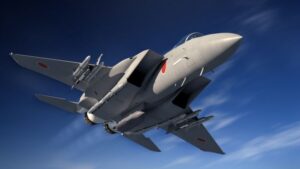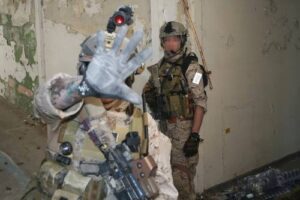The following article first appeared on Warrior Maven, A Military Content Group member website. The US Navy plans to fly “Combat Collaborative Aircraft” drones from its aircraft carriers in coming years, a possibility now within sight given the Navy’s successful operation of a first-of-its-kind carrier-integrated Unmanned Air Warfare Center.
The first operational Unmanned Air Warfare Center built into an aircraft carrier is, in the near term, intended to launch and operate the emerging MQ-25 Stingray refueler drone, yet the service is also looking toward future missions for the UAWC.
Naval MQ-25 Stingray Drone Carrier Launched
‘These systems will initially support the MQ-25 but also future unmanned systems such as Collaborative Combat Aircraft that comprise the Air Wing of the Future,” Unmanned Carrier Aviation (PMA-268) Program Manager Capt. Daniel Fucito,” said in an interesting essay from Naval Air Systems Command (NAVAIR).
The arrival of the MQ-25 Stingray is both anticipated and significant, given the way it can massively extend the combat reach of carrier-launched fighter jets; yet beyond this, the prospect of launching Combat Collaborative Aircraft from carriers is forward-thinking and arguably more significant because it means carrier-launched drones can perform a much wider range of missions beyond refueling to include forward surveillance, aerial “node” relay sensing, ammunition and supply delivery across domains in high-threat environments and even strike missions when directed by a human in a manned jet or ship-based command and control center.
The CCAs. as they are called, are intended to function as attritable, lower cost loyal wingman drones capable of supporting 6th-gen aircraft in flight; much has been discussed regarding the US Air Force application of CCAs designed to operate as part of a “family-of-systems” aligned with the now-developing Next-Generation Air Dominance (NGAD) 6th-Gen aircraft.
The Navy variant, called the F/A-XX has received less attention, yet it is extremely significant as it intends to sea-launch a high-speed, 6th-gen stealth fighter built with unprecedented air supremacy technologies. Added to this tactical advantage, the possibility of launching CCAs from carriers in support of the 6th-gen F/A-XX exponentially increases attack, surveillance and networking possibilities for Carrier Air Wings. A 6th-generation manned stealthy fighter jet supported by a small fleet of unmanned CCAs multiplies maritime warfare possibilities by enabling a jet to operate surveillance, networking and attack drones from the air in the cockpit. Also, a 6th-gen manned aircraft, or Navy F/A-XX, could network with the now operational UAWC to collaborate upon and coordinate drone carrier take-off-and-landing as well as mission programming, targeting and multi-domain information sharing.
The following article first appeared on Warrior Maven, A Military Content Group member website. The US Navy plans to fly “Combat Collaborative Aircraft” drones from its aircraft carriers in coming years, a possibility now within sight given the Navy’s successful operation of a first-of-its-kind carrier-integrated Unmanned Air Warfare Center.
The first operational Unmanned Air Warfare Center built into an aircraft carrier is, in the near term, intended to launch and operate the emerging MQ-25 Stingray refueler drone, yet the service is also looking toward future missions for the UAWC.
Naval MQ-25 Stingray Drone Carrier Launched
‘These systems will initially support the MQ-25 but also future unmanned systems such as Collaborative Combat Aircraft that comprise the Air Wing of the Future,” Unmanned Carrier Aviation (PMA-268) Program Manager Capt. Daniel Fucito,” said in an interesting essay from Naval Air Systems Command (NAVAIR).
The arrival of the MQ-25 Stingray is both anticipated and significant, given the way it can massively extend the combat reach of carrier-launched fighter jets; yet beyond this, the prospect of launching Combat Collaborative Aircraft from carriers is forward-thinking and arguably more significant because it means carrier-launched drones can perform a much wider range of missions beyond refueling to include forward surveillance, aerial “node” relay sensing, ammunition and supply delivery across domains in high-threat environments and even strike missions when directed by a human in a manned jet or ship-based command and control center.
The CCAs. as they are called, are intended to function as attritable, lower cost loyal wingman drones capable of supporting 6th-gen aircraft in flight; much has been discussed regarding the US Air Force application of CCAs designed to operate as part of a “family-of-systems” aligned with the now-developing Next-Generation Air Dominance (NGAD) 6th-Gen aircraft.
The Navy variant, called the F/A-XX has received less attention, yet it is extremely significant as it intends to sea-launch a high-speed, 6th-gen stealth fighter built with unprecedented air supremacy technologies. Added to this tactical advantage, the possibility of launching CCAs from carriers in support of the 6th-gen F/A-XX exponentially increases attack, surveillance and networking possibilities for Carrier Air Wings. A 6th-generation manned stealthy fighter jet supported by a small fleet of unmanned CCAs multiplies maritime warfare possibilities by enabling a jet to operate surveillance, networking and attack drones from the air in the cockpit. Also, a 6th-gen manned aircraft, or Navy F/A-XX, could network with the now operational UAWC to collaborate upon and coordinate drone carrier take-off-and-landing as well as mission programming, targeting and multi-domain information sharing.
The US Navy has spent many years pushing the envelope of technological possibility in an effort to successfully navigate an unmanned system carrier-deck launch and landing, and the service’s efforts now appear to be culminating in the successful launch and recovery of the MQ-25 Stingray from the USS George H.W. Bush (CVN 77). Landing a drone on a carrier first emerged roughly 10 years ago when, after much research, development and testing, the Navy successfully launched a Northrop Grumman X-47B demonstrator drone from a carrier deck. This, Navy engineers and weapons developers explained, required years of advanced computing and engineering as special algorithms had to be created to enable an unmanned system to endure and navigate the variables and complexities associated with a carrier landing. While the task has historically been quite challenging for manned fighter jets seeking to land on a carrier, humans can adapt quickly and with knowledge of turbulent sea states, changing wind conditions, combat complications, darkness or even sustaining incoming enemy fire. These tasks require human judgments and capabilities, and an ability to respond quickly to fast-changing maritime combat conditions. They are therefore much more difficult for a drone to perform, yet the Navy has made great progress and has now successfully built a carrier-based drone command and control headquarters and drones capable of landing with little to no human intervention.



